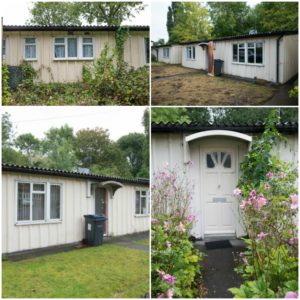WAKE GREEN ROAD PREFABS – MY LIFE IN ONE
Terry Bates, a past resident of the Wake Green Road prefabs, recalls his youth spent there:
Much has been written about these buildings that were erected as a temporary measure in 1945. They still stand today and I’m sure that the walls could tell many tales about life therein. As a resident for over 20 years, I’ve gathered my thoughts and hope that you’ll find them interesting.
We were the first occupants of one of the prefabs, having moved from rented accommodation near Moseley Road Baths. My father wasn’t a well man, suffering from TB and I understand that this moved us up the housing list. I was nearing two years old when we moved in November 1945 and it was my brother’s fourth birthday. Mother must have been very busy, what with two small sons and a sick husband.
Although I was too young to recall the story, I remember my mother telling me that German POWs laid the paving slabs outside the prefabs in 1946 and ‘Fritz’ was talking to me and me to him. We couldn’t understand each other though! I believe that German POWs were still in the UK until 1948.
Sadly, my father died in 1947 and I too suffered with TB which meant long spells of lying in the garden to ‘take in the fresh air’. It obviously worked! All through the bitterly cold winter of 1946/47 life must have been especially difficult for Mother. I’ve read about fuel and power shortages and snow on the ground well into ’47. Rationing was still around as well but the good thing about those days was how neighbours supported each other. I’m referring here to the prefab people as the residents in the private houses opposite didn’t have any contact with us for as long as I lived there. I remember prefab neighbours sharing ‘a cup of sugar’ or a ‘bucket of coal’ occasionally.
As I grew up, I began to take stock of the prefab’s interior and, contrary to what I’ve read about them being designed to give a “Cottage feel” they failed on that count. For their overall size, they were well designed but, boy, were they cold in the winter and difficult to heat! We had a small coal fire in the lounge with a back boiler and a forced hot air system that was supposed to feed to the bedrooms but it didn’t work. The walls were very thin – just plasterboard – and the windows were made from galvanised metal. On cold days, ice would form on the inside of the windows.
The kitchens were quite well laid out with an electric cooker and washing boiler and later on, a fridge was fitted; there were fitted cupboards as well. The clothes wringer was kept outside near the back door. We ate at a table in the kitchen most days with the lounge table being used for special occasions. We had meals cooked on a very restricted budget and of course rationing was still around in our early days. I recall the mincer being used on Mondays to use up Sunday’s left overs and we’d have those old staples like bread and butter pudding and spotted dick for pud. What’s happened to those?
The lounge and bedrooms had fitted cupboards and wardrobes and the hallway had a cupboard by the front door and an airing cupboard next to the bathroom. The toilet was separate.
Milk was delivered by TASCOS and our ‘divi’ number was written on the wall by the back door by Ted the delivery man. I remember WACADEN also delivering milk in the road using a horse and cart. Maturi’s van would visit occasionally to offer a knife and lawn mower sharpening service. And I’ll never forget the rag and bone man with his horse drawn cart coming down the road shouting “Rag Bone”.
For entertainment, we had an ECKO radio that received the Home Service and the Light Programme. I can recall listening to programmes like Children’s Favourites with Uncle Mac when kids always wanted to hear Sparky the Piano! We’d also listen to Educating Archie (a ventriloquist on the radio!), The Goon Show and on Sunday lunchtimes, Two Way Family Favourites. We didn’t have a TV until about 1958 and that was rented. A telephone was never installed in our prefab and my brother recalls one being put into one a few doors down which needed BT to put in their own telegraph pole! There was a Fire Service alarm box on the pavement outside No 427, painted red of course, and I believe it was put there as the nearest telephone box was too far away. Actually there was a telephone box at the top of Brook Lane hill. I can’t recall the red box ever being used or any fires in the prefabs.
We did get broken prefab once but as we didn’t have anything of value, the burglars picked the wrong one! They robbed the electric coin meter and took my college brief case as well. Some use that would be!
On a lighter note, I remember a story of one neighbour lying in bed and seeing a mouse in the hallway. He picked up his size 11 boot and threw it, missed and hit the wall with such a thump it made a hole in it, such was the weakness of the wall!
The River Cole would occasionally flood over the road at the bottom of Brook Lane at Coleside Avenue. We’d put our wellies on and help push stranded cars out. Some would tip us. As for pedestrians, we helped them by taking some orange boxes and setting them up as stepping stones. The tips helped towards our firework fund.
In all the years of living in the prefab – I moved out on my wedding day in 1969 – I never once envied those who lived in bigger or more permanent houses. Would I go back to living in one? I don’t think so as they were cold, draughty and must have cost a fortune in electricity bills. Don’t get me wrong, we were grateful of a good home to move into and a ‘home’ we made it. We were detached, had good honest neighbours and lived in a good area of Birmingham. The lessons I learnt in those days stood me in good stead for the rest of my life. Both my brother and I managed to move on to rewarding careers, in my case, one that enabled me to see many parts of the UK and the world. I’ll always be proud of my prefab days though.


